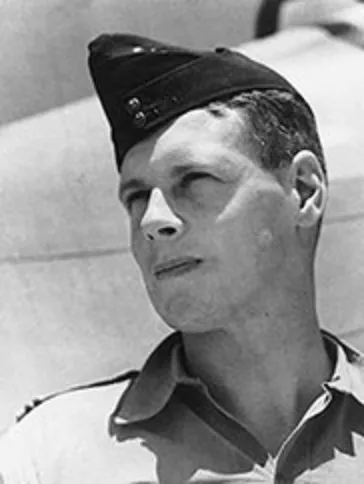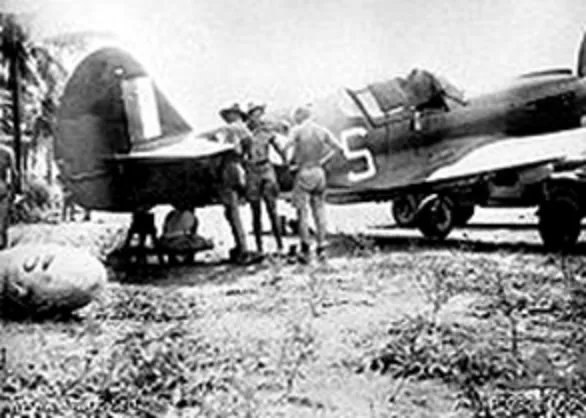WGCDR Wilfred Stanley Arthur 565
DSO, DFC



| Squadron/s | 75 SQN 76 SQN |
| Rank On Discharge/Death | Wing Commander (WGCDR) |
| Nickname | Wilf, Woof |
| Date of Birth | 07 Dec 1912 |
| Date of Death | 23 Dec 2000 |
Wilf was born on the 7.12.1919 and joined the permanent R.A.A.F. in 1939 before WWII began and was still undergoing pilot training, when he departed for Egypt in July 1940 with No. 3 Squadron R.A.A.F.
By December of the same year, he had his first victory, dispatching an Italian Fiat Fighter, flying a Gloster Gladiator bi-plane. At war's end he was officially an 'Ace' with eight confirmed combat victories to his credit.
Wilfred Stanley (Wilf) Arthur DSO, DFC (7 December 1919 – 23 December 2000) was an Australian fighter ace of World War II. He is officially credited with shooting down ten enemy aircraft. Joining the Royal Australian Air Force (RAAF) the day after war was declared, Arthur first saw action with No. 3 Squadron in North Africa, where he was awarded the Distinguished Flying Cross.
Posted to the South West Pacific, he commanded first No. 75 Squadron, and later Nos. 81 and 78 Wings, earning the Distinguished Service Order. At 24, Arthur was the youngest Group Captain in the history of the RAAF. He also played a leading part in—and gave name to—the "Morotai Mutiny" of 1945. He was commonly known as "Woof",and sometimes "Wolf" or "Wulf".
Arthur was born in Sydney, the son of a stock inspector from Goondiwindi, Queensland, near the New South Wales border. His early schooling was at Yelarbon, to which he commuted on horseback. Later he attended The Scots College in Warwick.
Arthur was 19 years old and still at The Scots College when he joined the RAAF on 4 September 1939, the day after Australia's entry into World War II. Training at RAAF Station Richmond, he was commissioned a Pilot Officer and served initially with No. 22 Squadron. Wolf once said on an interview, “I think you'd have to be bloody stupid if you were not afraid. Of course, the situation is that you're so busy in combat that ... you get involved in what's happening and that's – that occupies the mind wonderfully..”.
In 1940 Flying Officer Arthur was posted to No. 3 Squadron, based in North Africa. Piloting a Gloster Gladiator biplane, he scored his first victory by shooting down an Italian Fiat CR.42 north-west of Sofali on 12 December 1940. The next day he himself was shot down by a CR.42 and had to bail out. Promoted to Flight Lieutenant, Arthur was awarded the Distinguished Flying Cross for destroying four enemy aircraft in a single engagement near Bir El Gubi on 30 November 1941, the citation noting his "great skill and gallantry".
Flying a P-40 Tomahawk, he claimed two Ju87 Stukas, one Fiat G.50 and one Macchi MC.200. Arthur met his future wife, Lucille, in Alexandria. They married on 24 December 1941 and honeymooned in Palestine and Syria.
Completing his tour with No. 3 Squadron, Arthur was posted to the South West Pacific, where he flew P-40 Kittyhawks with No. 76 Squadron in New Guinea from April 1942 to January 1943. He was then promoted Squadron Leader and appointed Commanding Officer of No. 75 Squadron.
Arthur was awarded the Distinguished Service Order for his "gallantry, matchless leadership and devotion to duty" on 14 April 1943. Despite his guns having jammed, he led 34 Allied aircraft, including Kittyhawks of Nos. 75 and 77 Squadrons and P-38 Lightnings of the USAAF, to intercept 100 Japanese raiders over Milne Bay. The plane he flew, a Kittyhawk named "Polly", later went on display at the Australian War Memorial, Canberra. Arthur described the situation of being in combat without armament as "sort of awkward. Fortunately nobody else would know except me."He was promoted acting Wing Commander in June and became Wing Leader of No. 71 Wing. On 5 November 1943 Arthur was involved in a collision at Kiriwina Airfield with a Spitfire of No. 79 Squadron. The Spitfire pilot was killed, and Arthur received serious burns. He was repatriated to Sydney where he underwent plastic surgery at Yaralla Military Hospital (now Concord Hospital).
After his recovery in April 1944, Arthur attended the RAAF Staff School for three months before taking over command of No. 2 Operational Training Unit. In August, at the age of 24, Arthur was promoted temporary Group Captain, the youngest in the RAAF. That December he became Officer Commanding No. 81 Wing of the Australian First Tactical Air Force (1TAF) in the Dutch East Indies.
In addition to receiving the DFC and DSO, Arthur was twice Mentioned in Dispatches.[20][21] His official final tally of victories was ten enemy aircraft destroyed.
As previously mentioned Wilf married during his time in the Middle East and on being posted back to Australia, managed to spirit his wife aboard the troop ship amongst several nurses who were returning home. In April 1942, he was posted to 76 Kittyhawk Sqdn. An a few months later this Unit moved to Milne Bay in PNG, where for several months the Squadron was in countless desperate operations against the Japanese ground, sea and aerial forces. After the tide had turned against the Japs, 76 Squadron moved to Darwin, but Wilf remained in PNG as Wing Commander and CO of 75 Squadron and was in due course elevated to the rank of Group Captain.
It was in this capacity that he and a number of other distinguished R.A.A.F fliers became involved with the top brass in an altercation known as 'The Morotai Mutiny', which was their stand against the fact that the Americans had relegated Australia’s Forces to the dangerous and unnecessary task of mopping up stranded Jap forces. Woof said, “I knew I'd wreck any air force career ... but I couldn't face up to people getting killed when there was no bloody reason to.”
A top level inquiry completely vindicated Wilf's stand which together with many other examples of his fine leadership are fondly remembered by those who knew him or served alongside this well respected airman.
Wilf died in Darwin N.T. On Dec 23, 2000
